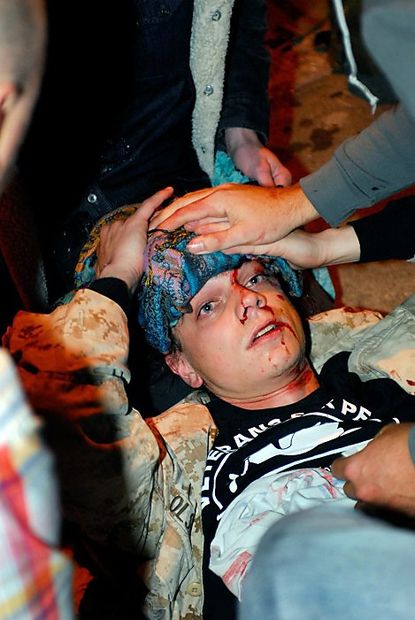
"He was standing perfectly still, provoking no one," said Raleigh Latham, an Oakland filmmaker shooting footage of the confrontation between police and hundreds of protesters at 14th Street and Broadway. "If something didn't hit him directly in the face, then it went off close to his head and knocked him down."
The something was a projectile that apparently came from police lines, fractured Olsen's skull and put him in Highland General Hospital. Doctors upgraded his condition Thursday from critical to fair, and said they expect him to make a full recovery.
His parents flew in from Wisconsin and spent Thursday at his bedside. When they arrived, Olsen "just blossomed," said Highland's chief of surgery, Dr. Alden Harken.
Olsen's injury added to the national attention focused on Occupy Oakland in the aftermath of the repeated police tear-gassing of protesters Tuesday. In Las Vegas, protesters projected a photo of the Marine in uniform onto the corrugated-metal side of a building at their camp, the Associated Press reported. Vigils for Olsen were planned at Occupy sites in other cities.
Mayor's visit
Mayor Jean Quan visited Olsen in the hospital, told him she was sorry for what happened and promised an investigation, said Highland spokesman Vintage Foster.
Olsen, a Daly City resident and member of Iraq Veterans Against the War, fell to the ground after police lobbed or fired an object - possibly a tear gas canister - at a group of protesters.
While Olsen lay wounded in the street, other protesters rushed to his aid. Video footage appears to show an officer tossing another canister toward the group helping him.
One protester can be heard screaming "What the f-" at police as the device emits a loud bang, while a demonstrator angrily pounds his sign on the street. The group eventually carried Olsen away.
Interim Police Chief Howard Jordan called the incident "unfortunate."
"I wish that it didn't happen," Jordan said. "Our goal, obviously, is not to cause injury to anyone. ... We regret that this injury happened."
Officers from 18 law enforcement agencies were on the streets of Oakland Tuesday night, and authorities said they are trying to determine which officers were involved in Olsen's injury. Quan said officers from outside agencies had been told they had to abide by Oakland police procedures.
Olsen joined the Marines in 2006, served two tours in Iraq and was discharged in 2010, according to Iraq Veterans Against the War. Now a systems administrator at San Francisco software firm OPSWAT Inc., he had spent most nights during the last few weeks at the Occupy SF camp, said his roommate, Keith Shannon.
"He'd leave work, head there, sleep there and go to work the next day," Shannon said. "We were really against the fact that the banks and corporations were not held accountable for what they did."
BART to Oakland
When Olsen heard that protesters at Occupy Oakland were asking for support, he took BART to Oakland and joined in the protest, Shannon said.
Olsen knew he might be arrested, but didn't have any idea the demonstration would get as violent as it did, Shannon said.
Harken said Olsen had suffered a 2- to 3-inch fracture on the left side of his skull. He is able to write and move, but is having trouble speaking, Harken said.
Olsen has a bruise on his brain that is causing swelling, but he should recover fully without needing surgery, Harken said.
Olsen was dropped off at the hospital by people in a private car and was unconscious for 12 hours, Harken said. He is unaware of the global interest in his condition.
"He wouldn't be able to comprehend it," the doctor said.
Chronicle staff writer Henry K. Lee contributed to this report.



He and his family should sue the city into oblivion.
This is obvious police brutality.
While I realize it won't change much, it will most definitely put a dent in the system.
Hope he heals up completely -- my best wishes to him.